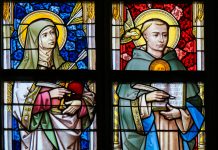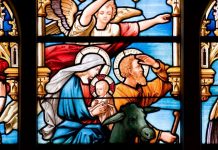
by Jeanne Heiberg
Serenity, peace, security, relaxation, comfort, loving parents, siblings, love, joy: These are some of the words people responded with when I asked for a word that says home to them. There also are well-known sayings that convey the warmth of the word home: Home is where the heart is. Home Sweet Home. Make yourself at home. Be at home here.
“Home for the holidays” is another familiar phrase. Christmas, especially, is when families get together in homes decorated with evergreen wreaths, Christmas lights, and piles of presents under the tree—with smells of baking and roasting that promise a feast soon to be shared.
Longing for Home
Christmas is when people at a distance most long for home. It also can be a time when we think about our heavenly home, as we celebrate Jesus’ arrival on earth to open the way for us to go there when our earthly life is complete.
Heaven is the place where God resides. In the Lord’s Prayer, Jesus even gave us God’s address: “Our Father, who art in heaven…” (see Matthew 6:9).
We tend to think of heaven as “up;” in fact, both the Hebrew and the Greek words for heaven mean “a place that is high and lofty.” Heavenly thoughts lift us up in mind and heart and make our earthly home a happier one. Our heavenly home is going to be glorious, and our earthly home can be pretty wonderful, too.
Home in Scripture
Earthly homes have always been important to us. In ancient Israel, a man’s home was considered so important that those who had built a new home were exempt from battle until after the housewarming (see 1 Maccabees 3:56). But even the happiest home is simply a foretaste of the heavenly home to which God calls us.
The prophet Isaiah paints a glowing picture of the heavenly home awaiting those who are faithful (see Isaiah 65:21-25). Our true home is in heaven with God. Jesus said, “In my Father’s house are many dwelling places.… I am going to prepare a place for you” (John 14:2). Jesus opened the way for us to go there after our life on earth is over, but the process begins long before we face death. Jesus said, “Behold, I stand at the door and knock. If anyone hears my voice and opens the door, [then] I will enter his house and dine with him, and he with me” (Revelation 3:20). These words certainly signify “home” as well as “heart,” two places where Jesus wants to meet and live with us.
The Communion we receive at Mass with our fellow worshipers is where we find God’s presence. In the home, communication and communing—sharing—is also where God is, especially around the sustenance of a meal shared by the entire household. That is where everyone’s earthly and emotional needs are met.
A family cannot build its home alone, however. Psalm 127:1 proclaims that unless the Lord builds the house, they labor in vain who build it. Those who work creatively with God—respecting and learning from God, observing God’s laws—will have that which makes for genuinely happy homes and families (see Psalm 128:1-4).
It’s important that Jesus be a part of our earthly home here and now. After all, home is where children are first formed in faith, where love is first experienced, and where knowledge of God begins. It’s where children know they belong—and every child needs that. Children’s experiences of home lay the foundation for knowing that they belong to God and God’s larger family.
The Domestic Church
The home is so important in faith formation that it has been called the domestic church. Home is the first of three pillars of faith education for children. The second pillar is the whole parish community; the third is the faith formation class.
Every home is different, and no home is perfect. But each home provides the first and earliest human experiences. As I wrestled with thoughts of balancing the joys and difficulties of home, and the range of home experiences from heavenly to horrible, I emailed some of my thoughts to Susan, a wise catechist and a grandmother. She wrote back:
“I am wondering about people who do not have such a happy homelife here and now. Lately, I think about many of the ways homelife has not been as happy as we would like, about the ways I have not been all I wanted to be as a wife and mother, and about what I carry from my own mother’s difficulties.
“Some children do deal with real difficulties. I think we want to take the happiness of Christmas at home with a loving family and extend that to the almost unimaginable joy of the constant presence and love of Jesus himself, and our entire family of brothers and sisters who are all God’s children, united in the Holy Spirit, one in peace and harmony. If we have difficulties with someone at home now, it will be like the lion and the lamb you see on so many Christmas cards. Whoever in our lives is the lion or the lamb, we will no longer try to fight each other, but instead lie down together and understand each other in harmony and peace (Isaiah 65:25).”
Susan realizes that the difficulties we encounter in life are contained and overcome when we are in touch with God, Jesus, and the Holy Spirit. In the midst of making our way in a concrete, material world, it’s often hard for us to remember that all visible things flow from invisible realities that we can’t see. Our openness to the unseen presence of God and our own invisible thoughts and feelings of faith, hope, and love eventually become visible in what we say, do, and accomplish over a lifetime. A life of care and concern for others, of sharing, and of living the teaching of Jesus every day make visible to others the presence of God. This often is very true at Christmas, when the “spirit of Christmas” makes the love of God evident.
Love Lives Here
The truly happy home has something that can’t be seen with bodily eyes, even with the best eyeglasses: love; caring; and the invisible presence of God, Jesus, and the Holy Spirit in the minds and hearts of those who live there. Love is what makes a happy earthly home. Love is also the sure way to prepare for our future heavenly home.
Our family home certainly is the most important one on earth, but we have many other homes as well. When I directed a catechetical program that was 25 minutes by car from my home, some Sundays found me at Mass where I worked, other Sundays found me in a parish closer to home. When I confided to the pastor of my neighborhood church, “I’m not sure to which parish I belong,” he answered with a smile, “How wonderful. You have two homes.”
The Universal Church; the Domestic Church
As Catholics in the Universal Church, we have a home wherever we travel in the world. Belonging to this great Church also gives the family home a special status; it has been called the domestic church. The Universal Church and the domestic church are places where we belong. Both bring people together to nourish and help each other. Each church supports and strengthens the other.
Being nourished in the bread and wine that is the presence of Christ sends us forth from the Mass to the world, back into our family home with the means to overcome any discord or difficulty that arises. Nourishment in our domestic church helps us use our gifts to build up the Body of Christ, the greater Church, with a contribution only we can give. Domestic and community churches build each other in a reciprocal way. Both are needed. Both are precious homes where we belong.
Say to the Children
If you have ever seen or read Little House on the Prairie, you may know that home is Laura Ingalls’ favorite word. Laura didn’t have an easy life. She had disappointments and tensions with other family members, but they were more than offset by love, lessons learned, and joy. She and her family help us understand that no home is perfect. Wherever there are different people with different needs, wants, and interests, there is bound to be some discord, conflict, disappointment, hurt feelings, and less-than-happy outcomes.
However, choices are open to us within our families. We don’t have to focus on what is lacking—on the faults and shortcomings of others. We don’t need to respond with anger or hold resentments. With the help of our good friend Jesus, we can choose to forgive, to listen, to try to see how others think and feel. We can do our best to be generous in sharing and meeting other people’s needs. When a brother or sister is annoying or gets a bigger piece of the pie than we get, we can be grateful for all we have. We can see the glass half-full of blessings rather than half-empty.
To a large extent, our thoughts and actions determine whether our earthly home—and our life in general—is a happy one. Right now, you can help to make your earthly home a foretaste of that heavenly home, even though it is still far in the future. It’s the people in a house that make it a happy home—and that includes YOU!
You don’t have to do your part alone. In Jesus, you have a friend, a helper you can always count on. There is a verse in Scripture where Jesus says, “Behold, I stand at the door and knock. If anyone hears my voice and opens the door, [then] I will enter his house and dine with him, and he with me” (Revelation 3:20).
What do you think Jesus means by that? Some say it means that he is knocking at the door of our hearts and our homes, that he wants to live with us, to dine with us, to talk with us, and to listen to us. Take some quiet time to be in touch with Jesus every day, to keep in touch with that invisible source of all good, God—alive in your mind, heart, and happy home.
To remember this, let’s make a collage of our earthly homes or our future heavenly home or both. You can put in roofs and windows and structures and people—whatever you see in your own house. You can also include symbols of what is invisible to the eye. This is easy to do at Christmas, a time when we decorate our homes with happy symbols of Jesus coming to us: wreaths, trees, candles, etc. Christmastime is a time when we make our earthly homes, in many ways, a foretaste of heaven.
ACTIVITY: Home Craft
MATERIALS
* large pieces of construction paper or drawing paper or card stock for background (use 12” x 18” size if you plan to portray both earthly home and heavenly home on one sheet; use 9” x 12” size to portray just one home)
* multi-color swatches of construction paper and origami papers, including gold if possible (metallic and holographic duct tape sheets are excellent)
* scissors
* glue sticks
* markers and crayons
PROCEDURE
1. Divide the background in half (a simple crease will do).
2. In the bottom half of the background, draw or use craft materials to construct the home you live in now. First, put in place the outer walls and the roof. Inside, draw furniture and people (or create a collage of these things). Be sure to include items and symbols that make yours a happy home—angels, hearts, sunshine, Jesus at the door or already inside.
3. In the upper half of the background, draw or use craft materials to construct your heavenly home, just as you would like it to be. Let your imagination go wild. Make it as glorious as you can.
Options: If you prefer, make only one home, your earthly home or your heavenly.
Blessing of a Home at Christmas
Opening Song: “All Are Welcome” (verses 1, 4, and 5). Marty Haugen, ©GIA Publications. Found in Breaking Bread, published by OCP.
Opening Prayer: Lord Jesus, you left your heavenly home to come to us, and you stand at the door and knock. May we open our hearts and our homes to you, that you may make our earthly homes places of peace, serenity, comfort, harmony, and happiness.
Thank you for our family homes and all the other places where we belong. As we decorate our homes for Christmas to celebrate your coming, may the lights, decorations, foods, and special treats say “welcome” to all. May there be laughter, joy, and happiness in our gatherings. May we put you where you belong—at the center of our festivities—to help us rejoice together.
All: Amen.
Closing Song: Sing your favorite Christmas carols (or do an internet search for the beautiful hymn “Bless This House”)
Jeanne Heiberg, MFA, is the author of Advent Arts and Christmas Crafts (Paulist Press), plus 15 other books and many publications, including Advent calendars. She has taught art, writing, creative catechetics, and meditation to all ages, and has directed parish catechetical programs. She thanks Susan Reinhold and Darlene, Des, Lukas (12) and Jacob (6) for home collages.
Copyright 2014, Bayard, Inc. All rights reserved. This article is protected by United States copyright and other intellectual property laws and may not be reproduced, rewritten, distributed, redisseminated, transmitted, displayed, published or broadcast, directly or indirectly, in any medium without the prior written permission of Bayard, Inc.
This article was written by the Catechist Staff and appeared in Catechist magazine, March 2014.
Image Credit: MIA Studio/Shutter Stock 557176453




